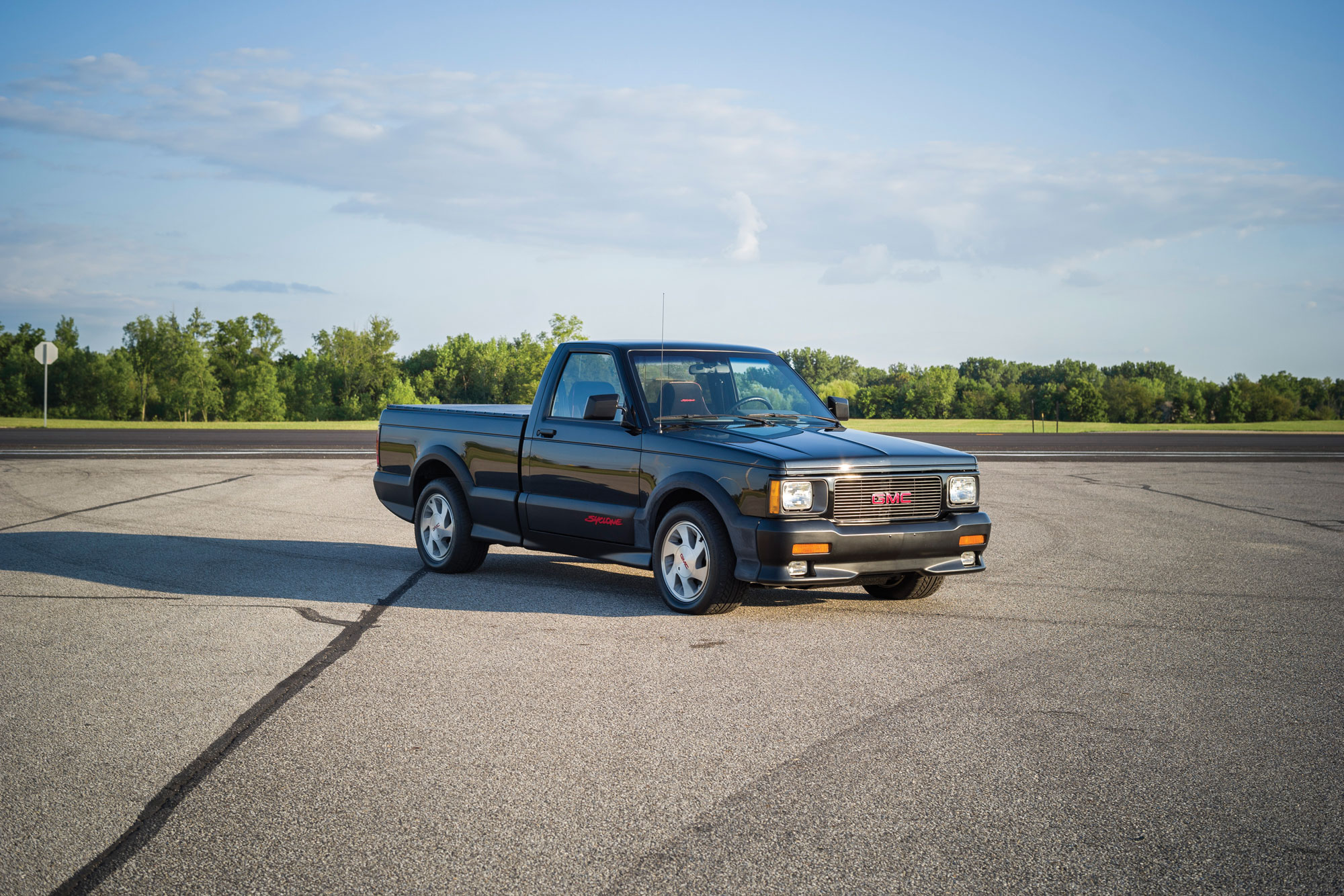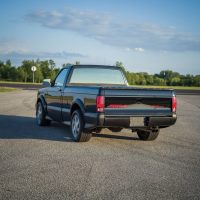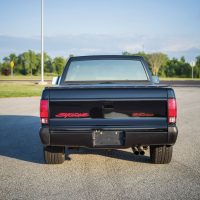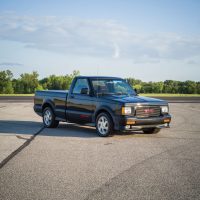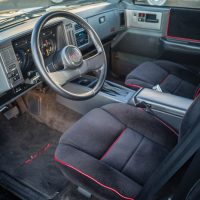- One of 2,995 produced for 1991
- 280-hp, turbocharged and intercooled 4.3-liter fuel-injected V6 engine
- GMC claimed a 4.6-second 0–60 mph time and 124-mph top speed
- Odometer displays 2,228 miles
- Automatic transmission; full-time all-wheel drive
- Finished in black over a matching black interior with red accents
- Air conditioning and numerous power amenities
- AM/FM radio with cassette player
SCM Analysis
Detailing
| Vehicle: | 1991 GMC Syclone |
| Years Produced: | 1991 (Three were built with a 1992 VIN; one was crash-tested, the other two are in private collections.) |
| Number Produced: | 2,998 |
| SCM Valuation: | $29,500 |
| Tune Up Cost: | $500 |
| Chassis Number Location: | Embossed VIN tag on the lower driver’s side base of the windshield, secondary VIN decal on the driver’s door |
| Engine Number Location: | Pad on the rear driver’s side of the block |
| Club Info: | International SyTy Registry |
| Website: | https://internationalsytyregistry.com |
| Alternatives: | 1992–93 GMC Typhoon, 1990 Chevrolet 454 SS pickup, 1993 Ford Lightning pickup |
| Investment Grade: | C |
This truck, Lot 4096, sold for $57,200, including buyer’s premium, at the RM Auburn Fall auction on September 4, 2020.
While Chevrolet may have birthed the 1990s performance-pickup era with the 1990–93 455 SS, it was GMC who refined the concept. While the 454 SS was essentially a muscle car with a bed, the Syclone is a full-fledged sports truck. With input from Buick’s engineering team (having time on their hands after the Grand National went the way of the dodo in 1987), the concept debuted at the 1989 Detroit auto show and was put into production in 1991.
Primarily built alongside the rest of GMC’s Sonomas at the Shreveport Assembly Plant, Syclones were completed by Prototype Automotive Services (PAS). This conversion involved stuffing the engine bay with a beastly turbocharged 4.3-L V6 making 280 horsepower and driving all four wheels. With the secondary production work, it’s little wonder that the MSRP was a nosebleed-inducing $25,970. (For an in-period comparison, I paid $9k less than that for a new, loaded 1992 Ford Ranger XLT SuperCab 4×4.)
Like a Ferrari
One thing to remember with these vehicles is that the drivelines, while based on common core components, are unique. Most folks don’t expect that a GMC pickup can have deferred maintenance issues like a Ferrari or other exotic. Just because the Syclone looks like a squatting Sonoma doesn’t mean the engine, transmission, transfer case, axles and suspension are shared with the garden-variety GM compact pickups. Quite frankly, the Syclone has more in common with a Chevy Astro Van — an overworked 700R4 automatic tranny and a BorgWarner AWD transfer case with a 35%–65% torque-split, front-to-rear. Indeed, unless you can find a GMC dealer who has an experienced Syclone technician on staff, you’re better off seeking out a specialist.
Both the Syclone and its successor, the 1992–93 Typhoon 2-door SUV, have seen a recent renaissance in interest. In a world in which SUVs are doing to sedans what kudzu does to a yard, where children have never seen a new Oldsmobile, Typhoons would seem to be a natural. Yet familiarity can also lead to contempt. Some youthful factions favor the Syclone because it is not a soccer mom’s SUV, preferring to think of it more as a two-passenger, body-on-frame coupe with a big honkin’ trunk.
Polished or preserved?
Our example, while showing 2,228 miles, has its share of imperfections. Most can be attributed to its three decades of existence. Light polishing scratches can be seen everywhere on the black paint. (The color does the owner no favors, showing every whorl and swirl, though perhaps if he had driven it more and polished it less…) Worse is that the right front section of plastic wheelwell molding has turned chalky at a greater rate than the other pieces on the truck — unfortunate, but far from unusual. Inside, the seats are just starting to show bolster wear — but less than the waviness and pillowing of the leather-wrapped steering wheel. The engine bay and undercarriage have the right amount of road grime to look the part for those miles, more akin to having been driven a bit and then parked back in its spot rather than having an owner with a predefined conservation plan.
A low-mile Syclone isn’t as much of a three-legged dog as some would think. While quite a few of these got the snot run out of them or got wrecked and parted out, it was also one of those vehicles that was an “instant collectible,” so a good percentage were pickled for posterity. Our example here really doesn’t fit in any of those boxes. I’d call it “used sparingly,” so for retail-plus money, it would seem to have sold well. And for 2020, it did.
Dream of the ’90s
Yet if one looks forward, the Syclone is already the pickup from the era that is the most recognizable and desirable. It also is one of the few 1990s trucks (if not the only domestic vehicle) that resonates with the “Youngtimer” crowd, simply because of its notoriety and the performance chops to keep up with (and usually surpass) the European and JDM dream machines from this period.
With an additional year of production and a hair over 1,700 more built, Typhoons have always lagged Syclone values by roughly 5%–10%. Five to six years ago, when values first ratcheted up (they’ve remained generally flat since), it was the Syclones that led the uptick.
While one sale isn’t the market, I get the feeling that this is the start of another general upward shift in values. Strong sales of just about any sub-5k-mile 1990s pickup during this past year and the trend of paying up for better quality only reinforce that thinking. If you’ve been on the fence about selling yours — or getting a nice Sy/Ty before they jump again — I think we’re approaching a tipping point. ♦
(Introductory description courtesy of RM Auctions.)
